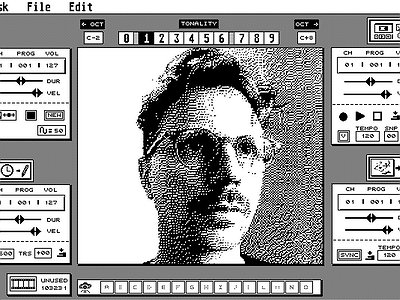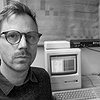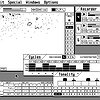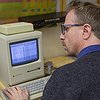Part 1
Name: Kristen Roos
Occupation: Composer, sound artist, producer, educator
Nationality: Canadian
Current release: Kristen Roos's Universal Synthesizer Interface Vols I & II are out now, distributed via We Are Busy Bodies.
Recommendations:
Book - The Hairy Who? 1966-1969
In the past year I’ve discovered a group of artists known as The Hairy Who that were based in Chicago in the late1960’s. Their art has a really fresh quality to it that feels before its time, and looks to me like a lot of the graphic novels and illustrative work that is all around us today. This is a fantastic book to discover this work.
Piece of art: Marion Tuu’luq - "Together in Spring," 1977
Textiles: Wool, embroidery
I saw a retrospective of her work at the National Galley of Canada in 2002. She was an Inuit artist from Nunavut who was really groundbreaking in the way that she created a kind of textile painting with wool, felt, and embroidery.
More recently I was able to see a similar textiles exhibition last year at The Textile Museum of Canada, called Double Vision, with the work of Jessie Oonark and her two daughters Janet Kigusiuq and Victoria Mamnguqsualuk, that was incredible. I really resonate with the textiles from Nunavut, and admire the way they use flat imagery in a minimal way.
If you enjoyed this Kristen Roos interview and would like to stay up to date with his music and projects, visit his official homepage. He is also on Instagram, Facebook, and twitter.
When I listen to music, I see shapes, objects and colours. What happens in your body when you're listening? Do you listen with your eyes open or closed?
I like to listen to music with my eyes closed. I do this when I’m at home listening on headphones or with speakers, and also when I’m at live performances. I have seen shapes and patterns at times, but these aren’t really tangible objects. They are more abstract and tied to the feelings and emotions that are created from the sounds entering and exiting my listening space.
Recently, when I was at an ambient music festival on Galiano Island this summer called Active Passive, I was able to get to a deep place when listening to the acts at the festival. It was quite warm and all of the music was outside. There was a really nice spot in the middle of all of the speakers that was very expansive when used to its full extent. I bring this up, because it’s the most recent experience I’ve had with this kind of deep listening, where I was able to get into the liminal space between being awake and dozing off. To me this is a really nice space to be in.
To be clear, this is a sober experience, and it’s also a very comforting space for me. Like I said, I don’t see concrete physical objects, but I do have a kind of emotional landscape that takes place when listening. The closest thing that I can compare it to is a film. If you were to just take all of the emotional responses to a film, and separate it from the visual aspects.
As far as what happens to my body, when this kind of listening is at its best, I think it’s a comforting warm space to be emersed in. An expansive aural space that is beyond my physical body, and it’s kind of like waking up to re-emerge from this space.
What were your very first steps in music like and how would you rate the gains made through experience - can one train/learn being an artist?
I feel like I’m constantly learning, and constantly the student in many ways with my art. But I also feel there is an intuitive side to how I create, that I’m beginning to realize is like being conduit for something that comes from outside of me. It can be really helpful when a teacher can help to tune into this kind of creativity, to bring an awareness of the creative process. A good teacher is really helpful in so many ways.
My first steps in creating music, or sound really, was around 1988-1994, when I was thirteen to eighteen years old. I was using a combination of an SK-1 sampling keyboard, a micro moog, a no input realistic mixer set up with feedback loop, cassettes and records. I eventually started to play music with two of my friends, and we made what I now would describe as improvised music / noise, with a combination of acoustic and electronic instruments. I was not really aware of how this fit into a genre at the time, and the internet was really at its infancy, so all of this was created in a secluded way, through what felt right sonically.
When I was nineteen, I moved to Montreal to go to art school, in an interdisciplinary art program that allowed me to also enrol in an electroacoustic music program. This education was really affirming in terms of my direction with sound and synthesis. They taught the fundamentals of analogue synthesis using a large Aries wall sized modular unit. This included creating diagrams of routing, with symbols for voltage-controlled amplifiers, filters, etc. It was also tape heavy at that time, with a lot of the initial assignments recorded to reel to reel, with splicing assignments, and learning how to create tape loops and head echo.
The presentations of our work were also really interesting, as in those days we would have a concert hall in a kind of reversed audience / performer situation. The audience sat on chairs on the stage, and the speakers were set up in the rafters above the audience, beside the audience, and all the way up the inclined seating to the back of the hall. A really immersive sound experience, with the lights turned off for each piece, where the artist would diffuse the sound from a recording (which was on DAT or reel to reel tape) using a mixing board to send the sound to travel around the audience using the array of speakers. Each fader on the mixer was sent to a different speaker. 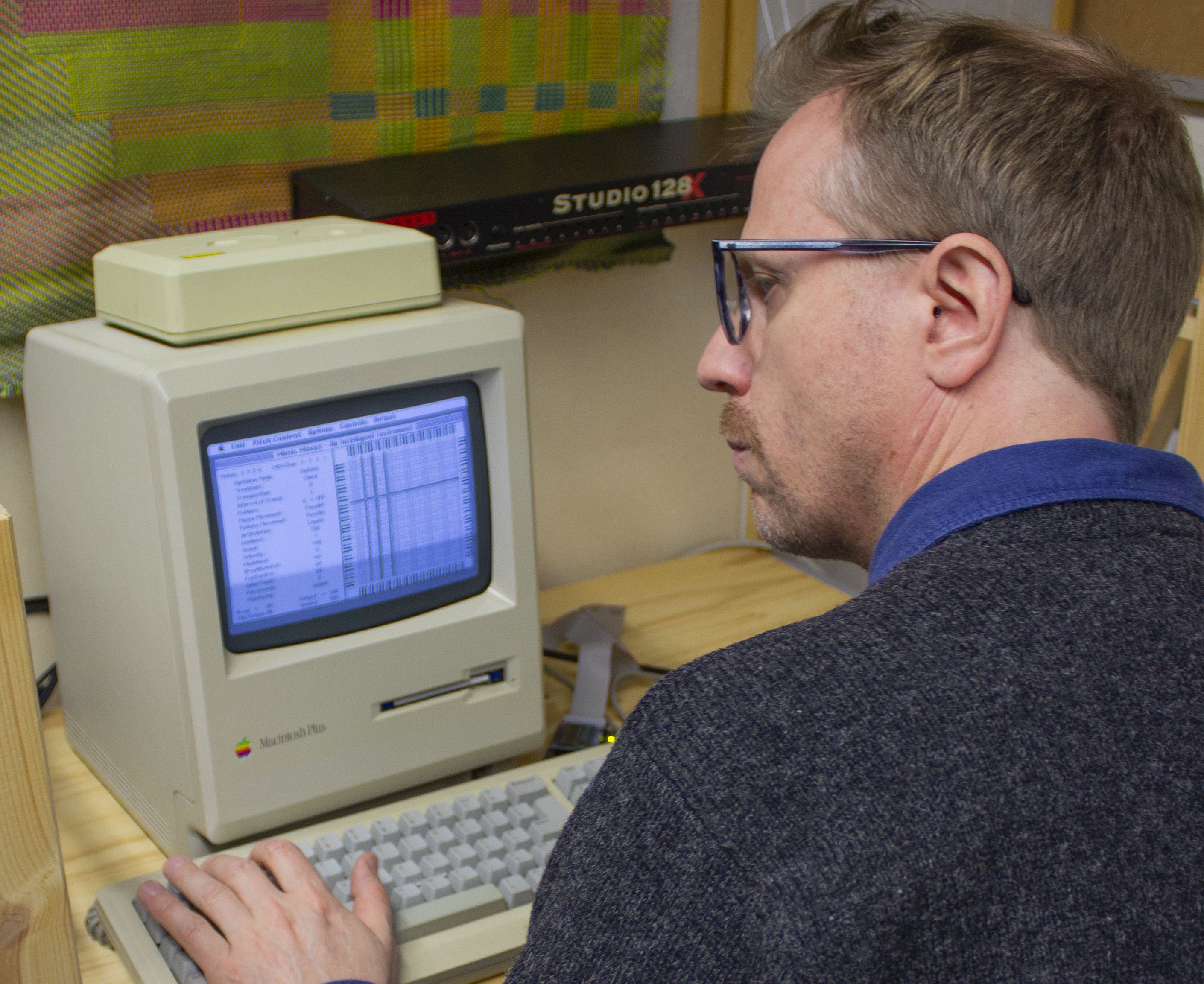
So, all of this being said, I had a lot of formal education with sound that encouraged experimentation from the time I was nineteen into my early twenties. This also included listening exercises, in which we were played recordings and asked to identify the piece, and composer, anything from musique concrete to plunderphonics. The concerts were a space that I first started listening in a deep way with my eyes closed.
So, in a sense I was taught how to listen, and also really learned how to use a sound studio as an instrument through a lot of experimentation time in the studio. I often booked the overnight time in the analogue studio, and spent the entire night there. This was also where I spent time in that liminal space before sleep, and at the time I found this space really inspiring and creative.
But like I said, I had a lot of inspiration and drive to create before any of this education, and I wonder if I would have eventually arrived at a similar place on my own.
According to scientific studies, we make our deepest and most incisive musical experiences between the ages of 13-16. What did music mean to you at that age and what’s changed since then?
I found this a really amazing fruitful time in terms of discovering music. I think the primary difference now is that I don’t have quite the same excitement I had when first discovering music. With discovering music today, it tends to be more about constantly comparing what I’m hearing to what I’ve already heard. Then analysing it in terms of influences and genres, and how it fits into a larger landscape of the history of music and sound.
When I was 13-16 I was really discovering music for myself, that was separate from the influence of my parents and what they listened to. I discovered music through a variety of ways that were part of the pre-internet days, from record stores, magazines, music videos, and the radio. Luckily Canada had a fantastic radio show that was on afterhours on CBC called Brave New Waves. You had to stay up late at night to listen to this program on a radio, or record it on cassette.
This aspect has changed immeasurably today, and music is both abundant, and more complicated in terms of the various mediums that it is delivered to an audience on today, and the mediation of technology, apps and the various paywalls, etc. I have discovered so much more music since these early teenage years, but I still tend to look back at this time with a kind of romanticism, as everything felt so new.
I was allowed to go out on my own from a very young age, and had been going to record stores on my own already from the time I was around ten years old. So, by the time I was thirteen or fourteen I was pretty independent in terms of my time outside of the house. I was really into going to local record shops to either find music that I’d heard about, or discover music through what was displayed and played in the shop and in the new release sections. I still have records that I bought at this time as I was excited about so many different styles of music that I still appreciate today.
Hip-Hop was extremely influential for me at this time, from1989-1992, and really got me thinking about the structure of loops and sampling (De La Soul, The Jungle Brothers, A Tribe Called Quest, Public Enemy, Boogie Down Productions, Ice-T, Erik B and Rakim, Beastie Boys Paul’s Boutique, NWA).
The first live Hip Hop show I went to was in 1990, and was De La Soul’s first tour. This music has had a lasting effect on me even today.
There was so much new music to discover, everything from the post punk/post no-wave and grunge acts, to shoe gaze, and the UK scene of next wave British invasion bands. (Sonic Youth, Fugazi, Minor Threat, My Bloody Valentine, Stereolab, The Happy Mondays, Primal Scream, The Charlatans UK, The Stone Roses, Lush, Nirvana, Firehose, Mudhoney). The whole world of techno and electronic music was super exciting, and electronic music and IDM was very influential as it there were forms that were emerging at this time (Aphex Twin, LFO, Altern-8, Autechre, Orbital, The Orb, Richie Hawtin, Underground Resistance, XL breakbeat, etc etc).
This era of electronic music was where in retrospect I realized that I had my first experiences with minimal music due to the samples that were in the tracks.
I had my first experiences dancing and taking hallucinogens when I was sixteen. At the time, the raves were playing a combination of industrial, techno, the UK bands that crossed over into the rave scene, disco, soul and funk. Ottawa was very close to Detroit and Windsor, and there were a few DJs that really focused on this scene of techno. It was a mind-expanding time, and I have distinct memories of paying attention to musical structure, tone and frequency.
Hearing all of this music amplified loud for the first time, and for me especially, experiencing bass at that level for the first time was therapeutic. To be able to dance in a space that was safe with no inhibitions, and really have a revelatory experience with music was really important.
What, would you say, are the key ideas behind your approach to music and what motivates you to create?
I have a pretty varied approach depending on the project. The most recent albums that I’ve released were created with vintage software and early algorithmic MIDI sequencing software.
The motivation for this work came from researching a specific moment in time in electronic music. I have always enjoyed research, and this topic in particular was one that involved a great deal of digging and looking for software and people to contact and correspond with who created the software. It also involved finding the vintage computers or emulators to run the software on, figuring out how each system works, and trying the software out by experimenting and creating music with my findings.
It was an ideal project for me, as it involved a conceptual idea, research, a connection to the past, discovery and experimentation. These are all things that motivate me to create.
To quote a question by the great Bruce Duffie: When you come up with a musical idea, have you created the idea or have you discovered the idea?
This is interesting to think about! I think that a few things are happening for me when I come up with a musical idea, and for sure it is partly a kind of personal discovery. A lot of the ideas are really just a culmination of all of the other musical ideas from the past mixed with the present, as I really believe that we are all connected on a deeper level, and artists may have a more honed sense of tuning into the ideas that are all around us. If you have time to devote your life to art, there is a different way of absorbing the world, and the inspiration to create comes from a combination of inner and outer experiences.
I think this question really points towards a larger question on where ideas actually come from, especially with artists / inspired ideas. I think a lot of people are still attached to a kind of genius artist idea, but I think as I get older, I realize that ideas may actually come from outside rather than inside, and there really is no original or genius.
Paul Simon said “the way that I listen to my own records is not for the chords or the lyrics - my first impression is of the overall sound.” What's your own take on that and how would you define your personal sound?
I can definitely relate to this quote, as I’m also very interested in the overall sound.
If I were to describe listening to my music, I would say that my biggest focus is on how the music is mixed. This includes things like panning, volume / amplitude, and the sonic quality of each sound that is entering the listener’s space. I really spend a lot of time in the mixing process, and it’s a huge part of my music. I think without my mix of the compositions, the pieces would be a completely different listening experience.
I would describe my personal sound as being really attentive to the timbre of each sound that I choose, and how these sounds enter and exit the listening space that is created by each piece.
Sound, song, and rhythm are all around us, from animal noises to the waves of the ocean. What, if any, are some of the most moving experiences you've had with these non-human-made sounds? In how far would you describe them as “musical”?
This question immediately made me think of a particular experience I had with frogs on one of the Northern gulf islands off the coast of Vancouver Island.
It was in the evening, and dusk settled into darkness as a I sat beside one particular pond that was full of frogs singing. I sat down just as they became silent, and as I sat listening to the frogs stop singing one by one, I realized that there was another pond that was quite a distance away starting up. And when that pond stopped the one that I was sitting next to started up all around me. I realized as each frog started, that I was completely surrounded by them, and it became a huge chorus of frogs that I was immersed in. They get so loud in this part of the world, and become something similar to being surrounded by a chorus of crickets. I realized that there was a back and forth singing that was happening between the two groups, and that it was a kind of a call and response to one another.
When you're sitting immersed in them, and one by one they start up at slightly different times, it’s almost like minimal music that slowly builds into a cacophony of voices. It builds up, and then breaks down again. A really moving enlightening experience.




